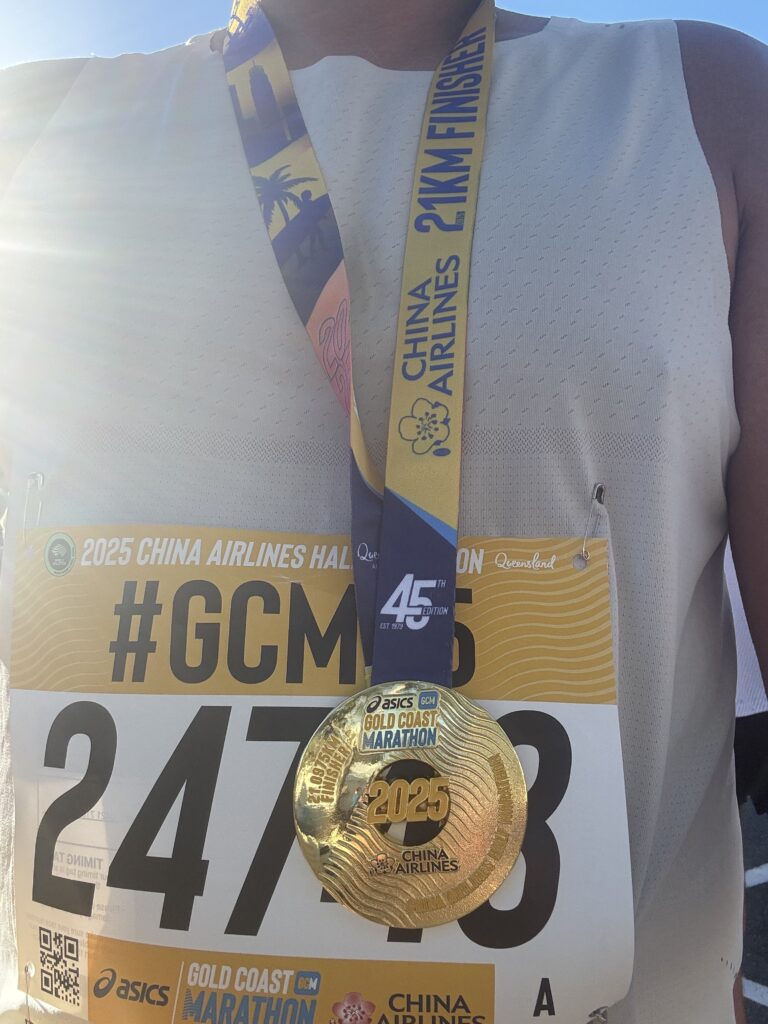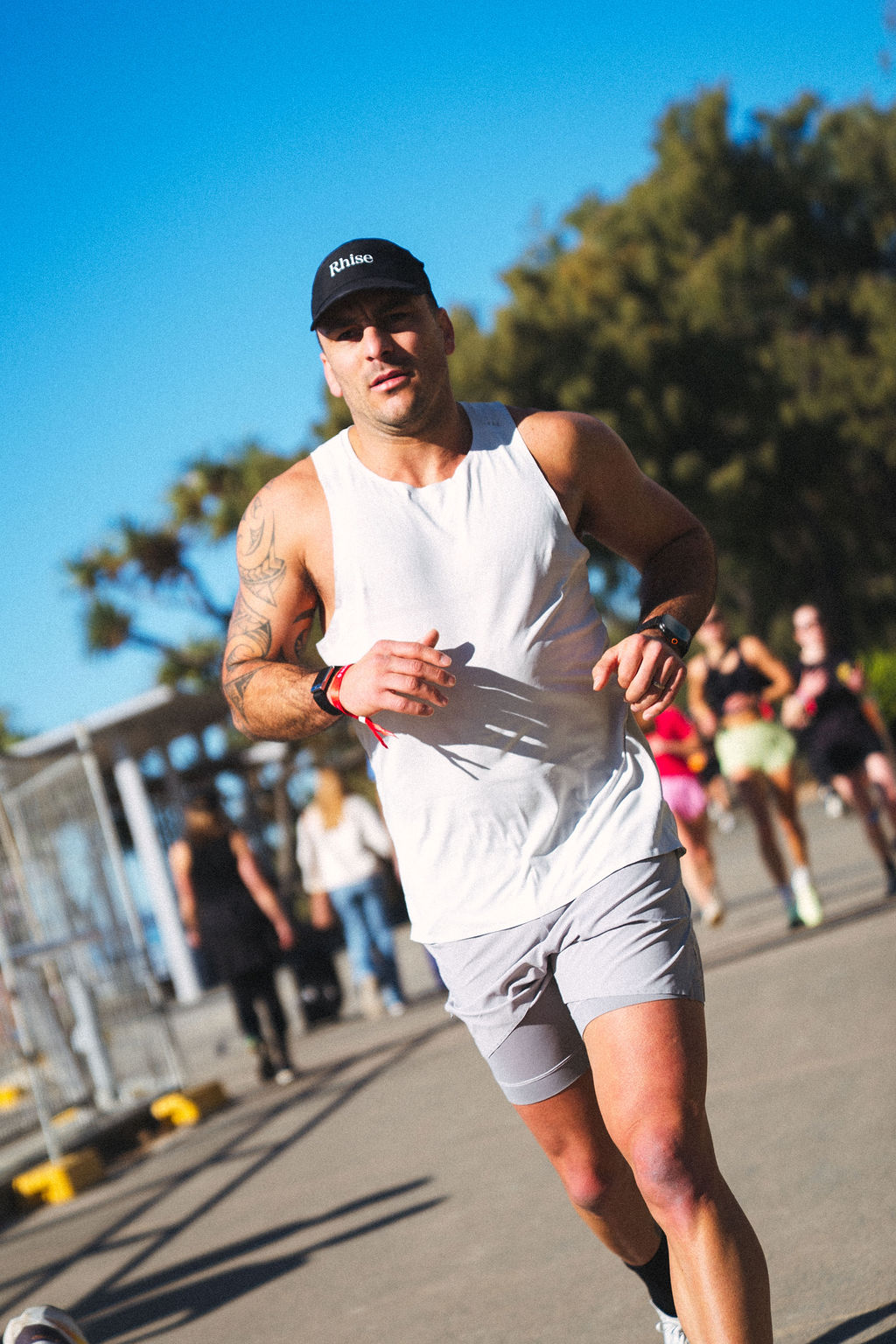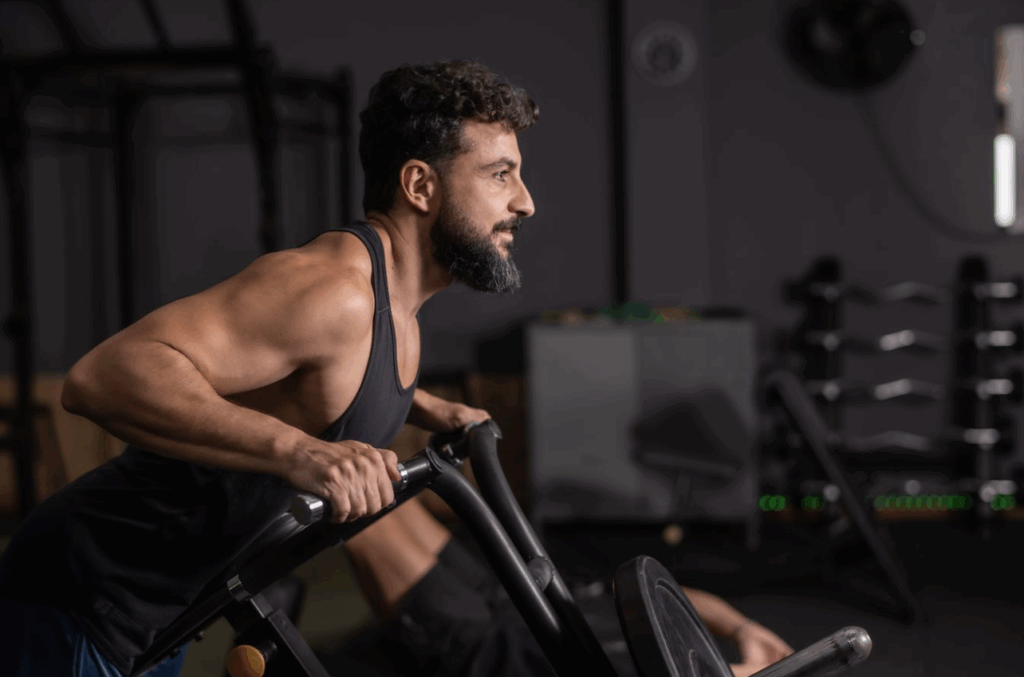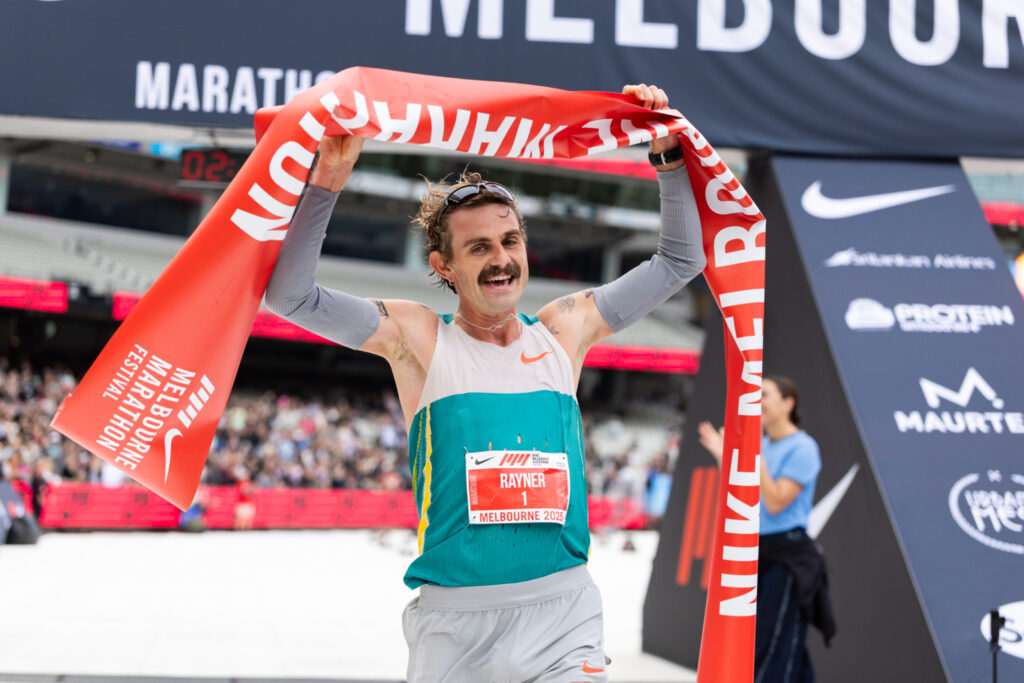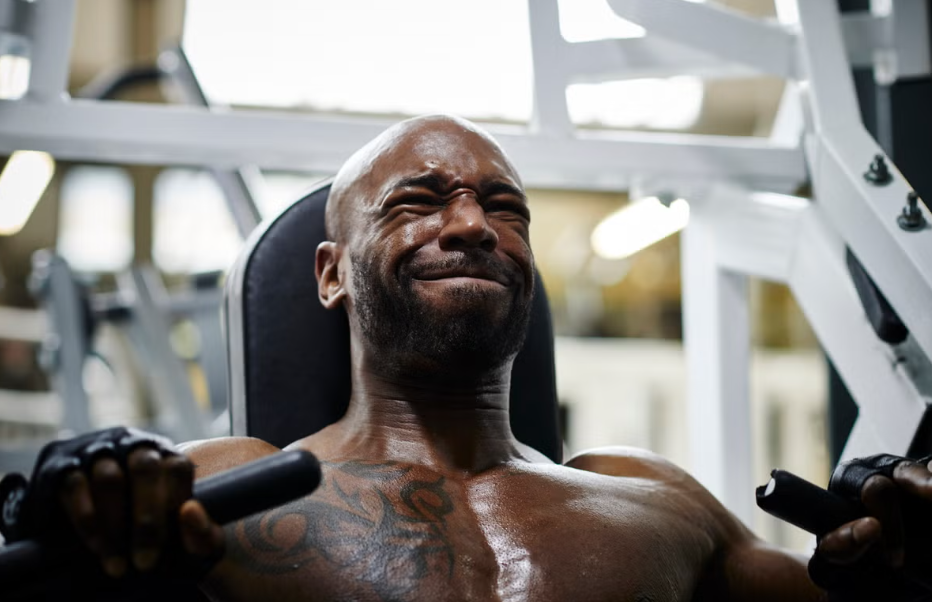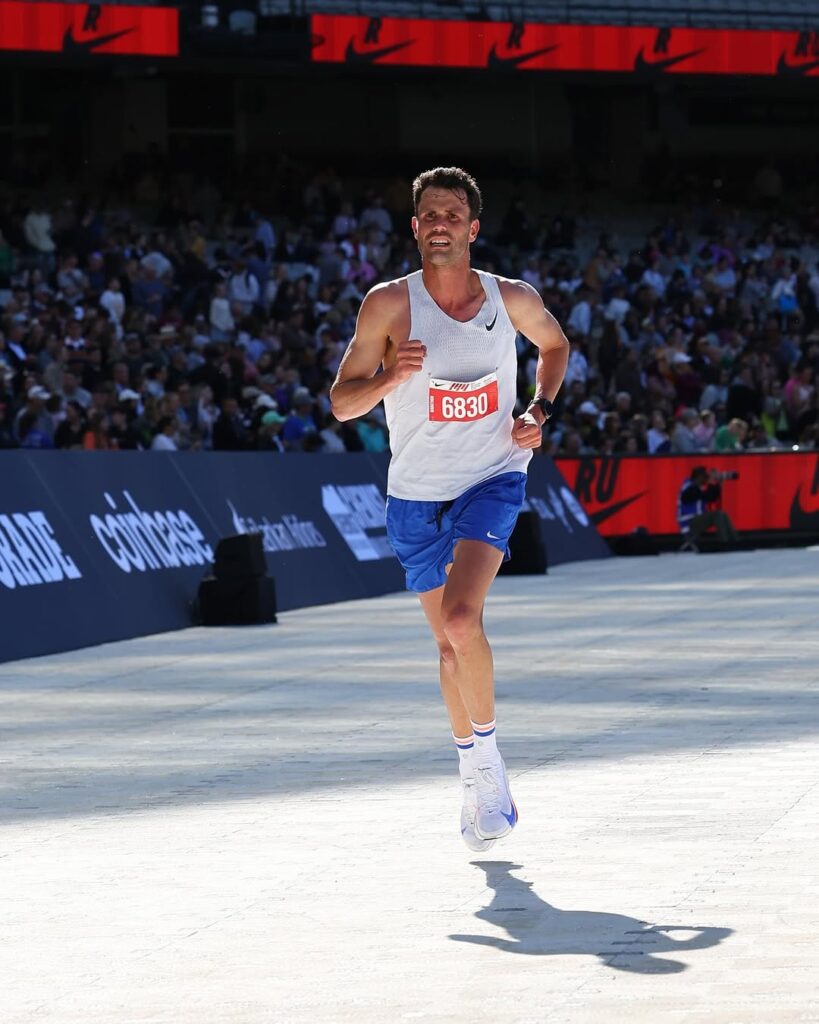TO USE A God-tier quote that’s mutated, through overuse, into a well-worn cliché, “Everyone’s got a plan until they get punched in the mouth”. The words belong to Mike Tyson in his ‘Baddest Man on the Planet’ days (rather than the shell of a fighter who lost to Jake Paul last November).
I’d heard the quote again from a fellow passenger on my flight up to this year’s Gold Coast Half Marathon, which I’m running as a guest of lululemon.
And right now, as I hit the 12km mark in the race, I’m turning the quote over in my mind. I’d had a plan, one my coach, lululemon ambassador, Ben Seymour (pictured above), and I had worked on together in the months leading up to this weekend.
I was aiming to beat my PB of 99 minutes and had followed a program – strictly for the most part – though not religiously enough as it would turn out, that Seymour had given me. I aimed to hit the 5km mark in 23 minutes and 10km in under 50. So far, so good.
Alas, it’s not to be. At the 12km mark, the proverbial punch in the mouth arrives in the form of severe calf cramps. As crippling pain radiates down the back of my leg, my plan is swiftly defenestrated (look it up) and to stretch Tyson’s metaphor to breaking point, my mouth is a bloody mess. Heck, I’m probably minus a tooth or two.
As I watch my race-pace begin to spiral from 4.40 to over 8 mins per kilometre, I know my hopes of a PB are over. I hobble through the next few kilometres feeling sorry for myself before eventually telling myself – you engage in a lot of mental dialogue during a half marathon – things could be worse.
Proof of this comes soon enough, as I watch a couple of blokes puking their guts up on the side of the road and then, even more acutely, if that’s possible, when I smell something vile behind me at the next drinks station. The smell is then beside me and then mercilessly disappears, as I look up and see the grim evidence of a woman’s soiled pants. Things could definitely be worse.
Somewhat buoyed by my comparatively mild predicament, I manage to break into a stride and, cheered on by the groups of enthusiastic spectators and their cheeky signs: “Bump here to power up”, “Nothing good ever came easy”, and “No one likes a fast finisher” among others, I manage a dignified stride to the finish, crossing the line in a tick under 2 hours.
Relief washes over me as my disappointment at getting injured dissipates amid the euphoria and ecstasy of my fellow finishers. I grab an orange and suck it for all I’m worth, as I take the obligatory selfie with the finisher’s medal around my neck.
My body is seizing up, quickly taking on the molecular properties of a rusted old pushbike, as I reflect on the race. The only conclusion I can reach is that running, like life, is what happens when you’re busy making plans.
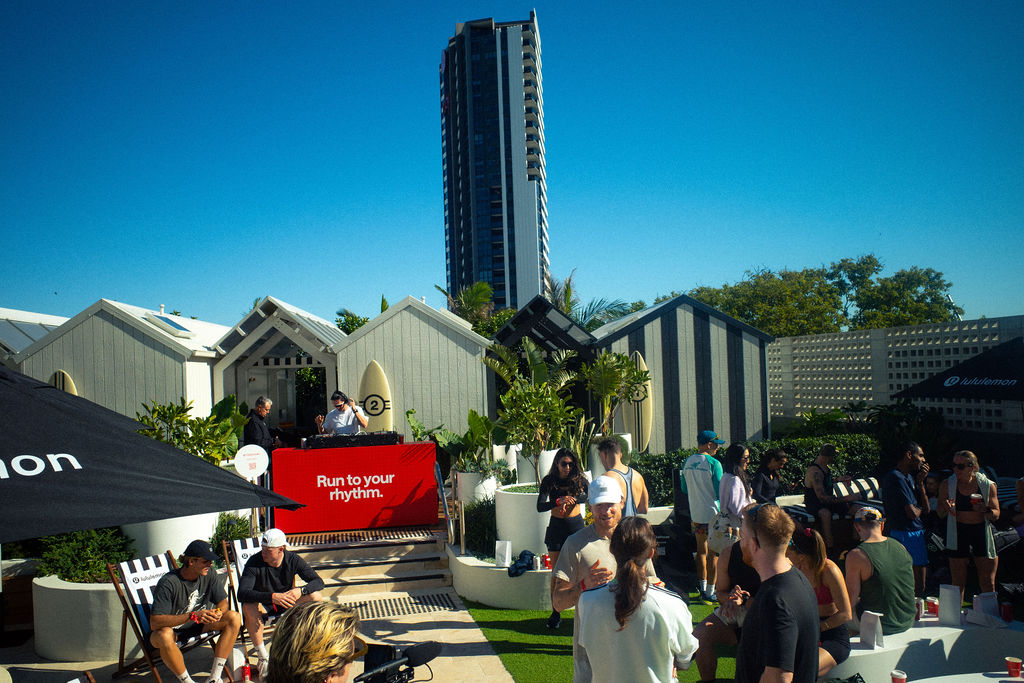
THE DAY BEFORE I’d caught up with Seymour at lululemon’s Clubhouse at the QT Hotel. The Clubhouse, which serves as our base for the weekend, is a community hub that brings together runners, crews and clubs over what is one of the biggest weekends on the Australian running calendar. It’s fully equipped with everything a runner might need, from pre-race supplements and snacks, recovery tools like Theraguns and Therabody JetBoots, as well as tunes from DJ Nick Drabble, whose playlist I use to try and drown out the mental chatter during the race. Each morning, there’s a shakeout run with ambassador Katie Martin and each afternoon a mindfulness movement session with fellow ambassador Ryan Mannix, which help runners get limber and mentally switched on for the race the following day.
The Clubhouse is a prime example of lululemon’s commitment, not only to supporting runners, but actively building running communities – there are folks here from all over the country, some from the elite end, like lululemon ambassador Jess Stenson, who will compete for line honours the next day, as well as first-timers, and those, like me, who are somewhere in between.
It’s after Mannix’s session on the afternoon before the race, that I connect with Seymour and we go over plans for the morning.
Seymour, a seasoned endurance runner and coach, plays a key role in bringing to life lululemon’s running vision, one that centres on movement, mindset and meaningful connection.
He tells me I’ve done the work and to go out and enjoy the race. He has his own long-term goal, he tells me, called Project 75, which is his attempt to run a half marathon in under 75 minutes. He’s not sure if he’ll get there tomorrow but it’s his goal for the year.
I ask him for some tactical race advice. He tells me to aim to sit just under my target pace. “Generally speaking, I would go just off pace for the first few kays, get into a rhythm, get comfortable and try and hold that and finish strong,” says Seymour, who last year took on the 145km TDS in France. “I think it’s much more pleasant to finish strong than it is to crawl to the finish line.”
He also warns me that I might not sleep well tonight. “It’s always an early start,” he says. “The last night before a race is the worst sleep ever. The nerves get you. No matter whether you’re the best runner in the world or you’re out there for fun, you still get nervous.”
Sure enough, I barely sleep before my alarm goes off at 3.50 am. It’s going to be a long day.
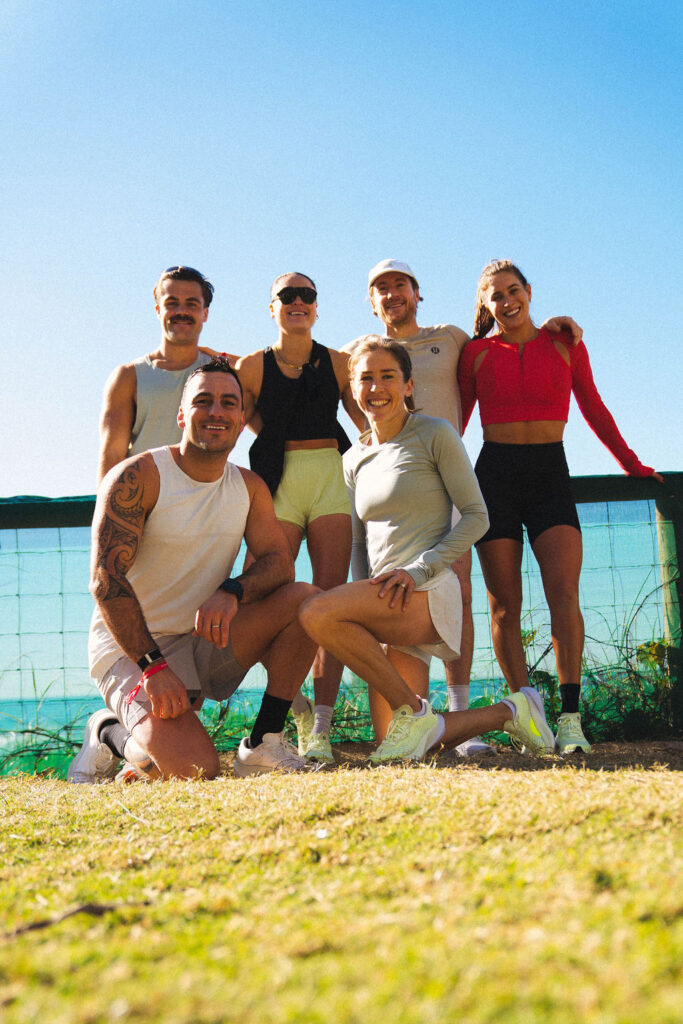
SEYMOUR HAD PUT together my running program based on the information I gave him. He takes a holistic approach to endurance training, blending structured performance strategies with recovery and mindset support. He also designs programs that are tailored, practical and adaptable, with an emphasis on consistency, strength and mobility, not just distance or volume. Training plans should be built around the individual, their lifestyle, goals and capacity, he explains, noting that as a lululemon ambassador, his coaching approach complements the brand’s philosophy: movement with purpose, recovery with intention, and performance without burnout.
In my case, I tell him that with work and family commitments I can only manage three sessions a week. Seymour says that’s the minimum for anyone wanting to run in the 1.40-1.50 range and recommends a fourth session if you can manage it.
“It’s like a juggling act,” he acknowledges of balancing training around your lifestyle. “Three sessions would definitely be the absolute minimum. The more that we can get in, even if it is an easy run, the better it’s going to be towards the end. Ideally, you’d like to have an easy run, a tempo run, a threshold run, and a long run”.
Interval sessions, Seymour notes, are the key to running faster, “allowing you to get used to your heart rate being at threshold and being able to stay calm while it’s hurting”, adding that hill sprints can help build leg strength.
Speaking of strength, the program Seymour gives me features a dedicated strength day in the gym. I have to confess that I do it for the first few weeks before letting it slide, a move that may have come back to haunt me and is perhaps responsible for my calf issues.
“A lot of people neglect strength training,” Seymour says. “I feel like it’s the one thing at the end of the race when you are really fatigued, that can enable you to keep going at a faster pace than people who don’t have stronger legs. It’s so important to mitigate risk of injury.” You live and learn, I guess.
Finally, we come to the fun part of the program – the taper. After building up to an 18km long run a couple of weeks out from the race, the final week is time to put your feet up, Seymour says. “Tapers are super important. It gives your body a rest, it gives your mind a rest. I think in that last week you can’t really get fitter. The best thing that you can do is recover as well as you can, get your sleep down pat, get your food down pat and get your hydration down pat. And then try to stay off your feet as much as you can.”
That I can do.
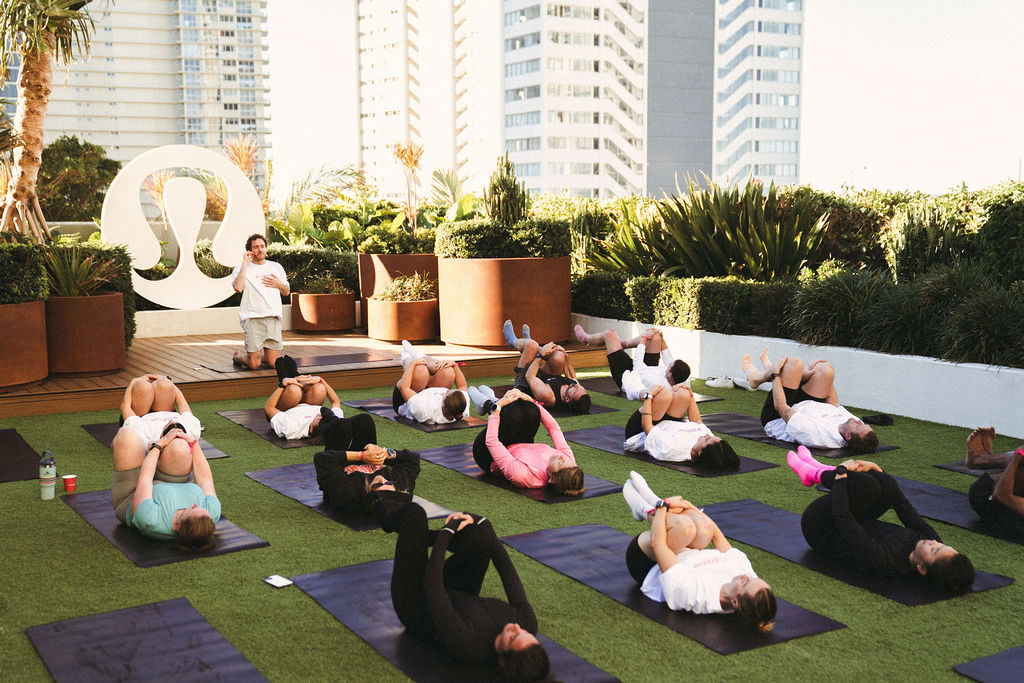
AT THIS POINT, it’s probably worth mentioning that Seymour is not your typical endurance runner. A former union player with the Western Force in Super Rugby, he transitioned into distance running after his career wound down.
He’s also an entrepreneur, recently launching the Rhise supplement line, which he describes as a complete fuelling system for endurance athletes, featuring premium, all natural ingredients. “Being able to support people who want to push their personal limits, whether it’s in business or physically as well, we can support them with supplements to ensure that they can achieve those goals,” Seymour says.
Last year, Seymour took on the Sur les Traces des Ducs de Savoie – which translates to ‘following the footprints of the Dukes of Savoie’, but is more commonly referred to as the TDS. It’s a gruelling 145 km odyssey though from Italy’s Aosta Valley to France’s Savoie region, in which competitors gain nearly 10,000 metres of altitude while traversing the Alps. I ask him how you mentally approach a shorter distance, like the GC Half Marathon, after previously taking on something so epic.
“I have enjoyed pulling it back to a shorter race where my long run is 90 minutes on the weekend rather than six hours,” he laughs. “It’s a completely different race. I redlined it [in the GC Half], so it’s definitely mentally taxing in a different way. But I’ve always done lots of different things, whether it’s weight training, HYROX or marathons. I pride myself on training for everything and being ready for anything.”
Indeed, Seymour reckons running at threshold pace in a half marathon is as physically and mentally taxing as the prolonged ordeal you face in an ultra. “They both hurt,” he says. “In the TDS race you’ve got 36 hours to go up and down mentally, whereas in the half marathon I really just had this little voice the whole time going, This is so fast, you can slow down, you can stop if your back’s sore. It was constant, telling me, Don’t worry, just stop. It’s all good, it’s all good. And I had to fight really hard on that one. I turned my music up as loud as I could and just told myself, Hurt today, you’re on holiday tomorrow. I’m proud that I didn’t give in at all because it’s brutal redlining like that.”
I confess I had similar mental discussions with myself after the calf cramping. Should I stop? What if I tear the muscle? I can’t wait to get into those Therabody JetBoots at the lululemon Clubhouse. Jeez, I’m talking to myself a lot . . .
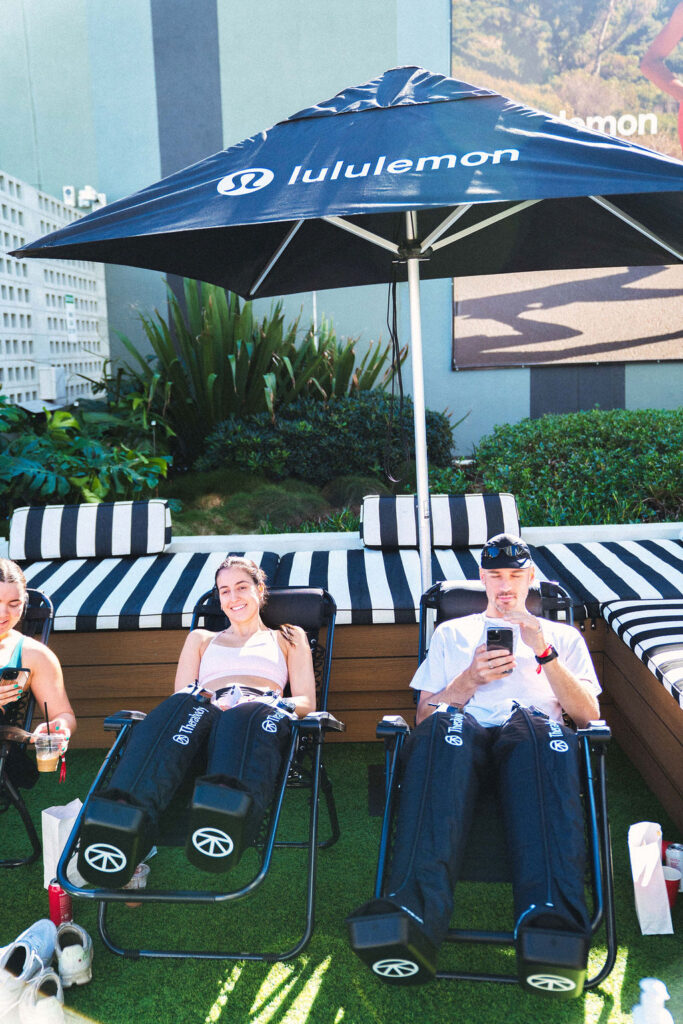
AFTER THE RACE, I do indeed, head straight to the lululemon Clubhouse, eager to indulge my mid-race fantasies of soothing my aching legs in those JetBoots and attacking my calf with a Theragun. By now I’m as stiff as a board but the place is full with runners who are moving like zombies but wearing the satisfied grins of achievement, relief or a mix of both.
The following day, after the marathon event, I attend a special recording session of the Inside Running podcast, powered by lululemon and hosted by Brady Threlfall, Julian Spence and Bradley Croker.
There is much talk of pacing at times that make me shudder. Croker, for example, says he won’t even bother showing up to this year’s Valencia marathon unless he’s confident he can be in the low 2.20 range, in what could be a humble brag but at this level is essentially just facts. One of the things I take out of the session comes from Spencer, who when reflecting on how runners feel after a race says, “This is running. If you took a poll of the audience, you’d find 60-70 per cent are disappointed with their time.”
I’m also heartened when fellow host, Threlfall, says, “The GC marathon is the devil. It’s a bit of a hoax up here. It’s known as a flat course and people think they’re going to run a PB and they find it’s hillier than they thought.”
Finally, Spencer makes a point all runners can relate to: the post-marathon blues. “You wake up the next morning and you’re like there’s nothing to train for and you’re like ‘what’s the point?’”
Later I ask Seymour if he can relate to these sentiments and if he has any advice on keeping running enjoyable, rather than getting sucked into the ups and downs of staying on pace and chasing PBs. He sees the journey as something that can forge resilience and build character, giving you tools that can transfer to other areas of your life.
“That’s something that you’ll take into everyday life,” he says of my decision to push on despite the setback with my calf. “For me, it’s like when I have a business meeting and it doesn’t go my way, how can I change my mindset?,” he says. “How can I deviate and come up with solutions.”
And what about post-race blues? “Race day can be brutal,” Seymour acknowledges, pointing out that he talked to three-time Olympian and lululemon ambassador, Jess Stenson, after the race, who perhaps hadn’t met her own exacting standards on this occasion. “Everyone’s their own harshest critic. I spoke to Jess after the race and I said, ‘Jess, well done great race’. And she was like, ‘Yeah’ and just moved on and it was obvious that she was really disappointed with the race. But to run 69 minutes is insane.”
Seymour urges you to use any disappointment you might feel as fuel. “Obviously you can be disappointed in it, but you can use it as motivation, work on some things you might need to work on in your training that you’ve found out in the race,” he says.
For me, that would be not to neglect the strength training that might have helped fortify my calves. For Seymour, Project 75 continues. “Personally, I was a little bit disappointed in my time [Seymour ran 79 minutes], but that’s what I deserved with the training that I’ve been putting in. We bank that, build on it as a foundation and go on to the next one.”
I nod, already thinking about how I’ll do things differently in my next race, as I start to realise something, if not profound, then certainly instructive: with running, getting punched in the mouth is part of the journey.
